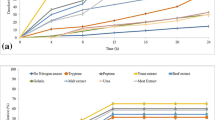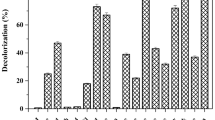Abstract
The textile-dyeing industry is rated as one of the foremost industrial sectors that explodes large amount of pollutants to the environment. Reactive azo dye degradation, being a major constituent of these pollutants and perilous material, has been constantly receiving scientific attention. In textile industry, use of Remazole Brilliant Violet 5R (RBV5R) as reactive azo dyes is more frequent. Highly competent, RBV5R-degrading bacterial consortium VIE6 was developed from the soil of the Vatva Industrial Estate, Gujarat, India. Consortium VIE6 comprised of five bacterial strains Bacillus sp. DMB1, Staphylococcus sp. DMB2, Escherichia sp. DMB3, Enterococcus sp. DMB4, and Pseudomonas sp. DMB5. These strains convened a better decolorization efficiency between 200 and 1000 mg/L of dye concentration and were much stable at pH 6.5, 37 °C. Azoreductase, laccase, and lignin peroxidase activities of consortium showed significant variation throughout the degradation process indicating the different metabolic capabilities of the existing microflora. The community interactions and synergism were shown to facilitate the biotransformation of RBV5R by combination of various electron donors. Voltammograms revealed the variations in electron discharge properties which coincide with the dynamics of community derived using qPCR assays. The variation in catabolic capabilities of the individual strains was observed during active metabolism of RBV5R degradation pertaining to the aerobic and facultative functions.






Similar content being viewed by others
References
Forgacs, E., Cserhati, T., & Oros, G. (2004). Removal of synthetic dyes from wastewaters: a review. Environment International, 30(7), 953–971.
Sandhya, S. (2010). Biodegradation of azo dyes under anaerobic condition, role of azoreductase. In H. A. Erkut (Ed.), The handbook of environmental chemistry (1st ed., Vol. 9, pp. 39–57). Berlin: Springer.
Stolz, A. (2001). Basic and applied aspects in the microbial degradation of azo dyes. Applied Microbiology and Biotechnology, 56, 69–80.
Lu, Y., Philips, D. R., Lu, L., & Hardin, I. R. (2008). Determination of the degradation products of selected sulfonated phenylazonaphthol dyes treated by white rot fungus Pleurotus ostreatus by capillary electrophoresis coupled with electrospray ionization ion trap mass spectrometry. Journal of Chromatography. A, 1208, 223–231.
Solis, M., Solis, A., Perez, H. I., Manjarrez, N., & Floresa, M. (2012). Microbial decolouration of azo dyes: a review. Process Biochemistry, 47, 1723–1748.
Diaz, E. (2004). Bacterial degradation of aromatic pollutants, a paradigm of metabolic versatility. International Microbiology, 7, 173–180.
Lorenzo, V. D. (2001). The potential of genetically modified bacteria to break down toxic pollutants in the environment. EMBO Reports, 2, 357–359.
Allen, E. E., & Banfield, J. F. (2005). Community genomics in microbial ecology and evolution. Nature Reviews Microbiology, 3, 489–498.
Hong, Y., Xu, M., Guo, J., Xu, Z., Chen, X., & Sun, G. (2007). Respiration and growth of Shewanella decolorationis S12 with an azo compound as the sole electron acceptor. Applied and Environmental Microbiology, 73(1), 64–72.
Forss, J., Pinhassi, J., Lindh, M., & Welander, U. (2013). Microbial diversity in a continuous system based on rice husks for biodegradation of the azo dyes reactive red 2 and reactive red 5. Bioresource Technology, 130, 681–688.
Jain, K., Shah, V., Chapla, D., & Madamwar, D. (2012). Decolorization and degradation of azo dye—Reactive Violet 5R by an acclimatized indigenous bacterial mixed cultures-SB4 isolated from anthropogenic dye contaminated soil. Journal of Hazardous Materials, 213–214, 378–386.
Kulla, T., Zimmerman, H. G., & Leisinger, T. (1982). Properties of purified orange II azoreductase, the enzyme initiating azo dye degradation by Pseudomonas KF46. European Journal of Biochemistry, 129, 197–203.
Hetvani, N., & Mecs, I. (2001). Production of laccase and manganese peroxidase by Lentinus edodes on malt-containing by-product of the brewing process. Process Biochemistry, 37(5), 491–496.
Shanmugan, V. Kumari, M. and Yadav, KD. (1999) n-propanol as a substrate for assaying the lignin peroxidase activity of Phaerochaete chrysosporium. Indian Journal Biochemical Biophysics 36-39.
Lowry, O. H., Rosebrough, N. J., Farr, A. L., & Randall, R. J. (1951). Protein measurement with the folin phenol reagent. Journal of Biological Chemistry, 193, 265.
Desai, C., Jain, K., Patel, B., & Madamwar, D. (2009). Efficacy of bacterial consortium-AIE2 for contemporaneous Cr(VI) and azo dye bioremediation in batch can continuous bioreactor systems, monitoring steady-state bacterial dynamics using qPCR assays. Biodegradation, 20, 813–826.
Telke, A., Kalyani, D., Jadhav, J., & Govindwar, S. (2008). Kinetics and mechanism of Reactive Red 141 degradation by a bacterial isolate Rhizobium radiobacter MTCC 8161. Acta Chimica Slovenica, 55, 320–329.
Banerjee, P., Talapatra, S. N., MandaI, N., Sundaram, G., Mukhopadhyay, A., Chattopadhyay, D., & Banerjee, S. (2008). Genotoxicity study with special reference to DNA damage by comet assay in fission yeast, Schizosaccharomyces pombe exposed to drinking water. Food and Chemical Toxicology, 46, 402–407.
Moosvi, S., Kher, X., & Madamwar, D. (2007). Isolation, characterization and decolourization of textile dyes by a mixed bacterial consortium JW-2. Dyes and Pigments, 74, 723–729.
Punj, S., & John, G. H. (2009). Purification and identification of an FMN-dependent NAD(P)H azoreductase from Enterococcus faecalis. Current Issues in Molecular Biology, 11, 59–66.
Liu, Z. J., Chen, H., Shaw, N., Hopper, S. L., Chen, L., Chen, S., Cerniglia, C. E., & Wang, B. C. (2007). Crystal structure of an aerobic FMN-dependent azoreductase (AzoA) from Enterococcus faecalis. Archives of Biochemistry and Biophysics, 463, 68–77.
Ali, H. (2010). Biodegradation of synthetic dye, a review. Water, Air, and Soil Pollution, 213, 251–273.
Fu, Y., & Viraraghavan, T. (2001). Fungal decolourization of dye wastewaters, a review. Bioresource Technology, 79, 251–262.
Guo, J., Zhou, J., Wang, D., Tian, C., Wang, P., & Uddin, M. S. (2008). A novel moderately halophilic bacterium for decolourizing azo dye under high salt condition. Biodegradation, 19, 15–19.
Kargi, F., & Uygur, A. (1996). Biological treatment of saline wastewater in an aerated percolator unit utilizing halophilic bacteria. Environmental Technology, 17, 325–330.
Peyton, B. M., Wilson, T., & Yonge, D. R. (2002). Kinetics of phenol biodegradation in high salt solutions. Water Research, 36, 4811–4820.
Mathew, S., & Madamwar, D. (2004). Decolorization of Ranocid Fast Blue Dye by bacterial consortium SV5. Applied Biochemistry and Biotechnology, 118, 371–381.
Elisangela, F., Andrea, Z., Fabio, D. G., Cristiano, R. M., Regina, D. L., & Artur, C. P. (2009). Biodegradation of textile azo dyes by a facultative Staphylococcus arlettae strain VN-11 using a sequential microaerophilic/aerobic process. International Biodeterioration and Biodegradation, 63, 280–288.
He, F., Hu, W., & Li, Y. (2004). Biodegradation mechanism and kinetics of azo dye 4BS by a microbial consortium. Chemosphere, 57, 293–301.
Sarayu, K., & Sandhya, S. (2010). Aerobic biodegradation pathway for Remazol Orange by Pseudomonas aeruginosa. Applied Biochemistry and Biotechnology, 160, 1241–1253.
Acknowledgments
This work was supported by the Department of Biotechnology (DBT) grant from Ministry of Science and Technology, New Delhi, India. Authors gratefully acknowledge Sophisticated Instrumentation Centre for Applied Research and Training (SICART), Vallabh Vidyanagar, Gujarat, India, for providing FTIR facility. Department of Chemistry, Sardar Patel University, is also duly acknowledged for extending their NMR facility.
Author information
Authors and Affiliations
Corresponding author
Ethics declarations
There are no ethical issues for this work and normal guidelines were followed.
Conflict of Interest
The authors declare that they have no conflict of interest.
Electronic Supplementary Material
Below is the link to the electronic supplementary material.
ESM 1
(DOC 704 kb)
Rights and permissions
About this article
Cite this article
Shah, B., Jain, K., Jiyani, H. et al. Microaerophilic Symmetric Reductive Cleavage of Reactive Azo Dye—Remazole Brilliant Violet 5R by Consortium VIE6: Community Synergism. Appl Biochem Biotechnol 180, 1029–1042 (2016). https://doi.org/10.1007/s12010-016-2150-4
Received:
Accepted:
Published:
Issue Date:
DOI: https://doi.org/10.1007/s12010-016-2150-4




